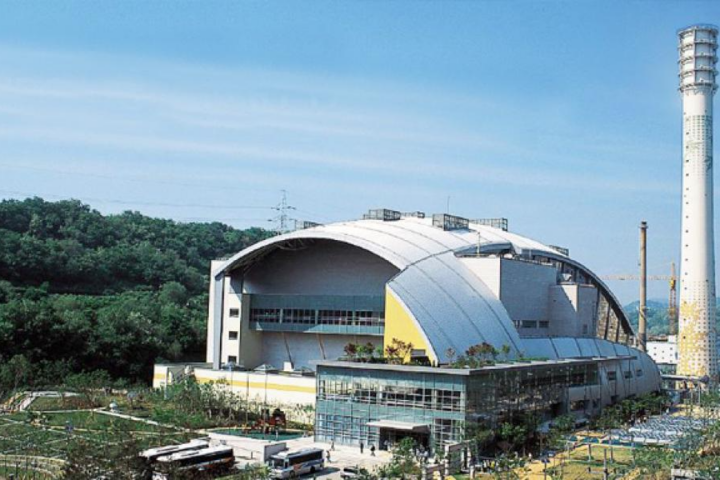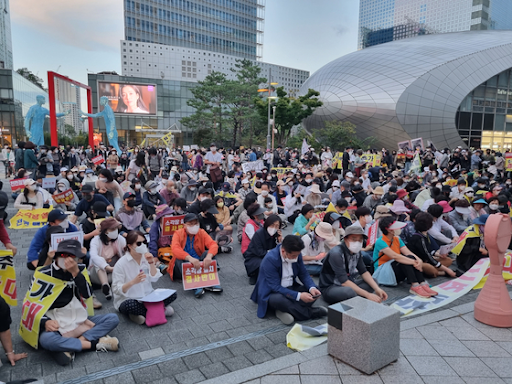
To Death Against Incineration: Sangam-Dong’s Climate Justice Battle
April 16, 2025By Jina Song, 2025 Future Blue Youth Council member
Cover photo source: Development Asia
When I returned to Sangam-dong after nearly a decade abroad, I expected to find the same lively parks and the familiar hum of my hometown. Instead, I was greeted by a sea of red and black banners, their bold yellow letters slashing through the streets like open wounds: “TO THE DEATH AGAINST THE INCINERATION FACILITY!” These weren’t just protest signs. They were survival signs. Despite the K-pop boom, despite the tourists, despite the thriving biodiversity, Sangam-dong was still being treated as Seoul’s trash bin.
When Seoul City approved a second waste incinerator in our neighborhood—right next to the existing one—people snapped. It would burn 1,000 more tonnes daily—burdening Sangam-dong with over half the waste of Seoul’s 9.77 million residents. The betrayal was too great. For years, we were told that Nanji-do, once a rotting landfill, had been reborn as an ecological haven– that this land, once suffocated by waste, had finally reclaimed its breath.
 Image Source: Korea Joongang Daily
Image Source: Korea Joongang Daily
And now? Another incinerator.
At first, I just watched. Then I found myself pulled in. I translated protest materials, designed posters, connected with GAIA (Global Alliance for Incinerator Alternatives), and spread awareness throughout the district. The movement evolved from outrage to strategy, from frustration to action.
Burned Enough: Sangam-dong’s Revolt Against Environmental Injustice
The media paid attention. The Hankyoreh, Mapo-TV, and M-NET TV all covered our fight. I worked with the Mapo district mayor to host the International Forum on Anti-Incineration, where Dr. Paul Connett, a leading environmental scientist, took the stage. He didn’t just validate our fears—he intensified them. Dr. Connett laid bare the truth: incineration wasn’t just bad for the environment. It was an assault on public health.
That forum changed everything. No longer was this just a neighborhood issue. Environmental groups, researchers, and activists from across Korea joined us. The deeper we dug, the clearer it became: Seoul City wasn’t just failing Sangam-dong—it was failing its entire population.
Global Recognition, Local Impact
Our fight didn’t stay within Korea. The New York Times recognized our story through my Open Letter Contest—the largest New York Times writing contest with over 8,000 applicants—catapulting Sangam-dong into the global spotlight. Earning the Honorable Mention Award for my open letter titled “Mayor Oh, Stop Suffocating Us With Seoul’s Waste,” I helped harness journalism to elevate our voices. Soon, what started as a local movement became an international example of environmental resistance.
Through our collaboration with GAIA, we connected with grassroots activists battling the same injustice. We studied alternative policies, pushed for efficient recycling incentives, and demanded fairness. We encapsulated the illogical push for an incinerator, transforming my open letter into action:
Excerpt from the Open Letter “Mayor Oh, Stop Suffocating Us With Seoul’s Waste,”
But Mayor Oh, Sangam-dong can’t overlook the promises Seoul City Mayors already shattered. In 1978, they constructed roads to unite and flourish Nanji-do—today’s Sangam-dong area. But your predecessors overturned the plans in just days. They designated Nanji-do as Seoul’s official landfill, casting a shadow of death over its future. They replaced nature’s vibrant hues with a mountain of waste that emanated a putrid stench.
But after decades of desolation, eco-rehabilitation clothed Nanji-do with hope. Steadily, nature unfurled its life. Still, the fire below the trash incineration facility pushes us back to the waste. Beneath the rich nature, 750 tonnes of waste rupture into flames in the Mapo incineration facility daily.
Next to this very site, you insist on constructing a second incinerator. Under the crushing weight of an additional 1,000 tonnes of trash, we will bear the burden of more than half the waste generated by 9.77 million people. Mayor Oh, how could you pound Sangam-dong with Seoul’s garbage so many times? Where is Seoul City’s promise for Nanji-do’s second life?
But this fight wasn’t won in newspapers or conference halls. It was won in the streets. The protests swelled. Students, business owners, and elderly residents marched side by side. For over a year, Sangam-dong’s voice echoed through Seoul. Blatant red signs tumbling down apartment walls. Banners hung from tree to tree. Sangam-dong simply refused to be silenced.
 Jina Song featured on Mapo TV and MBN News
Jina Song featured on Mapo TV and MBN News
Victory in the Courts
Then, against all odds, our community won.
In early 2025, after relentless advocacy and legal battles, the courts ruled against the incinerator project. The decision wasn’t just a technicality—it was a statement. Sangam-dong had shouldered through Seoul City’s legal prowess.
Ms. Yoon, one of our movement’s key organizers, said, “This isn’t just about stopping an incinerator. It’s about standing up to the pattern of environmental injustice that has targeted our community for decades.” The ruling acknowledged the blatant imbalance of waste distribution, the unchecked health risks, and the broken promises piled up as high as the old Nanji landfill itself. Another leader in our fight, Mr. Kim, emphasized: “People told us this was impossible. But when an entire neighborhood refuses to be ignored, even the biggest institutions can’t help but listen.” And listen, they did.
What Comes Next?
Stopping the incinerator was only step one. Now, we push for real solutions: zero-waste policies, stronger recycling programs, and transparency in waste management decisions. We’re also demanding accountability. If Seoul City claims to be a leader in sustainability, why is it still clinging to outdated, waste-burning methods? Why aren’t other districts sharing the responsibility?
“We don’t want another fight like this in the future,” said community advocate Mr. Sung. “We need a system that stops problems before they happen—one that treats every neighborhood fairly.”
This fight taught me something undeniable: you don’t need to be a politician to make a difference. Change starts with awareness. It starts with speaking up. It starts with refusing to accept “this is just how things are.” Sangam-dong took a stand. The smoke may have cleared, but our story is far from over. What will yours be?
Jina interviewed Sung, Kim, and Yoon in March 2025. Their first names have been omitted at their privacy requests.
Photos Credits: Development Asia, Korea Joongang News, Mapo TV, MBN News
